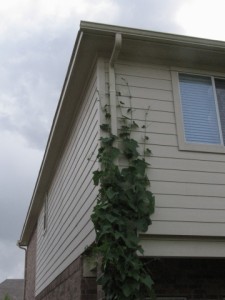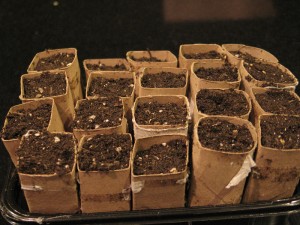Posted by Aimee | Posted in Garden Planning, Plantings | Posted on 13-08-2009
Tags: luffa sponges
Now, I have been gardening since I was a little kid and you would think by now I might know what I was doing, however, I have found that gardening is an ever learning sort of experience. No matter how much you learn it seems to me there is that much more to learn out there. All you can do is share what you do learn and keep reading and experimenting and learning from others. Why go to all this trouble? Because as you learn, your yields tend to improve, your costs tend to go down, the taste of your harvest tends to improve, and the effort expended tends to lessen. In my experience that is how it works at any rate.
I tell you this because I, being a rookie to the Texas garden, didn’t bother to read the plant specs carefully on a plant I decided to grow and these pictures show you the result. This plant is called Luffa Cylindrical, it is where those wonderfully fantastic luffa sponges come from. I read that it was a natural for my new environment and that it was highly ornamental and would grow vertically. What I failed to notice was the actual height this beautiful plant can get to, 30ft! So, as you can see it is taking over my house.
I would still recommend this plant to anyone even though I have not harvested any sponges as of yet because it has required almost no care, the bugs that have eaten everything else haven’t seemed to bother the Luffa, and because the leaves are very ornamental, they are bigger than my head even. Just be ready for the size of this. It was planted by seen on May 7th, and now, August 8th, just 3 months later it is taking over the world. I keep forcibly pulling it from the neighbor’s side of the fence every couple of days and I keep trying to find places to poke the searching shoots back into the jumble to keep it contained. I am especially surprised this plant has done so well since I had no room for it in my garden bed and had to plop it right on top of the sod I covered with some newspaper and a couple inches of dirt and then mulched them. Also, believe it or not, this mass of growth you see in the pictures all came from only 2 tiny seeds.
I am sort of thick headed though so it is good that I am reminded now and then to look before leaping. Next year, I am not sure how but I will be prepared before I plant my luffa, even if that means investing in a good machete to protect the neighbors!





